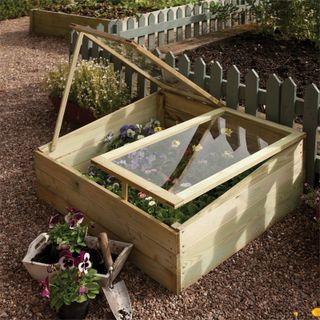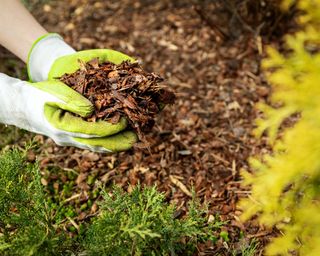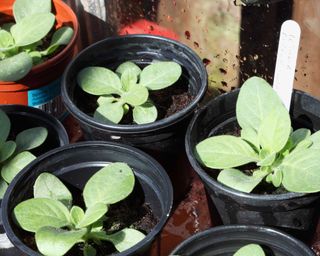How to protect plants from frost: help your garden survive the winter
Our expert tips on how to protect plants from frost will come in useful when the temperature drops


Learning how to protect plants from frost is a must if you're expecting colder weather this winter.
Some plants are hardy (and many of these bring welcome color and form to the winter garden). However, other, tender species will quickly freeze and die when it gets too cold – whether in pots or in the ground.
Being prepared and providing protection before this happens means you can keep these plants healthy and happy throughout the season. That way, you can enjoy them at their best once warmer weather arrives, rather than splashing out on replacements.
6 tips on how to protect plants from frost
These simple steps will help keep your plants safe from the winter chill.
1. Lift and store summer bulbs for winter
You can lift and store dahlia tubers, canna lilies, gladiolus, and other tender bulbs out of their pots and borders once the greenery has died down in late fall. These can then wait out the winter in a frost-free shed or garage, until it's time to replant them in spring.
In prolonged periods of cold, it may be useful to cover the boxes you store them in with an old blanket or fleece for extra insulation. Remember to check over them periodically for signs of rot, and discard any affected.
And, if frosts are forecast when your daffodils, tulips, and other spring favorites are already flowering, there are ways you can protect these bulbs from frost to help them survive, too.

Dahlia tubers need to be lifted out of their old compost and stored in a shed or garage until next year
2. Place your plants in a greenhouse or cold frame
There are some wonderful winter planter ideas that will brighten up a patio. But, not all container plants will withstand the cold, so will need protection if they are to survive the season.
If you have a cold frame (there are plenty available on Amazon) or a greenhouse, stand potted plants inside. If you don't, think about getting one – even if it's just a mini greenhouse – as they are invaluable.
'Unless you plan to add heating to your greenhouse, it will be regarded as "cold" in any description you read about greenhouse gardening,' says John Negus, an expert from Amateur Gardening magazine. 'However, it can still keep overnight temperatures as much as 41°F/5°C warmer than outside, which will keep plants frost-free in all but the worst of winters.
'However, I would always keep some horticultural fleece to hand to drape over plants on the coldest nights,' he adds.
The base of each pot should be off the ground, so you might need to use pot feet to raise them up. If there isn't enough space, lay them on their sides. It's important that the compost dries out and remains largely dry throughout the cold, dormant period, so avoid watering until spring.
On warmer days, ventilate your cold frame or greenhouse, but remember to close up before dark.

John has been a garden journalist for over 50 years. He has also written four books and delivered many talks on horticulture. As well as this, John regularly answers readers' questions in Amateur Gardening magazine, sharing advice for every season.

This cold frame from Homebase will keep out the worst of the cold
3. Use a garden wall to your advantage
If you don't have a cold frame or a greenhouse, you can still protect your container garden by arranging all your pots together against a sheltered wall of your house. The heating inside warms the exterior wall just a little, plus the wall offers support on windy days.
As with pots in greenhouses, lift each off the ground – with pot feet, for instance – to ensure good drainage.
Bear in mind that compost in pots is more vulnerable to cold than the soil of the garden, says John. Wrapping the pots in fleece, sacking, bubblewrap or even thick newspaper should keep them warmer. 'However, don’t cover the compost at the top of the pot, or the base, as the compost needs to breathe and drain,' he warns.
Wrapping the heads or stems of larger plants with fleece when frost is forecast will keep a degree or two of frost off, just remember to remove the fleece during the day. This can also help to protect your plants from snow.

Horticultural fleece can help keep your potted plants protected
4. Cover veg patches with fleece
A layer of horticultural fleece – available on Amazon – can be effective at keeping some of the frost off a vegetable garden. That is, as long as it was in place before the frosts arrived – so add it to your list of jobs when you're preparing the garden for winter.
Keep it raised above the plants with hoops to encourage air circulation, and peg or weigh the sides down so it doesn't blow away in the wind. The covers can be lifted on warm, sunny days.
If fleece is laid over already-frosted soil, it is unlikely to have an impact on warming it up, says John. In fact, it might even hold the frost in the soil for a bit longer – acting like a blanket and trapping the cold air in. If you have plants in your veg bed that might benefit from some protection, and frosts have already hit, it's still worth laying some fleece, though. But, wait until they have defrosted first, or have been warmed a bit in the sun.
For smaller plants and seedlings, you may wish to invest in glass cloches, which have a traditional charm. Just remember to prop them up with a small stone during the day to prevent too much moisture and heat from building up inside. Alternatively, these durable PVC ones from Amazon have adjustable vents on top for ease.

Winter veg can be protected with DIY covers
5. Mulch your borders
The best time for mulching your flower borders is in late fall, says John, before the soil hardens with frost. 'The mulch you apply now, which should be around 4in (10cm) thick, will help to insulate roots and crown buds from penetrating frost.'
This isn't the only benefit of mulching. 'Worms will incorporate whatever you are using – composted manure or well-rotted garden compost – to increase the depth of top soil and make it easier to cultivate plants and remove weeds,' John continues.
In milder regions, such as the south of England, some gardeners have success with mulching heavily over their summer-flowering bulbs instead of lifting them.

Mulching will help to protect some plants' root systems from frost
6. Don't plant tender bedding out too soon
If you've started off tender plants indoors (such as chrysanthemums, petunias, and many other bedding plants), only plant them out into the garden when you're certain all risks of frosts have passed.
In some regions, this can be as late as early summer. Do remember to harden them off first, though, which will help get them used to the change in environment.

Wait until the weather is warmer before planting out tender seedlings
How do you protect tropical plants from frost?
Many tropical plants, such as tree ferns, banana palms and cordylines, will struggle in cold weather and may need extra protection from frost.
One way to do so is to wrap them in a fleece jacket packed with straw. Tree ferns have a vulnerable crown that will need a protective layer, while the leaves of cordylines should be wrapped together to prevent water from collecting at the base and causing rot.
Succulents need to go under cover, too, unless you're lucky enough to have a slightly milder climate. You can also apply a thick mulch of leaves or compost to the roots of exotics to protect them.

Many tropical plants will need extra protection to survive colder temperatures

Lifestyle journalist Sarah Wilson has been writing about gardens since 2015. She's written for Gardeningetc.com, Livingetc, Homes & Gardens, Easy Gardens and Modern Gardens magazines. Having studied introductory garden and landscape design, she is currently putting the skills learned to good use in her own space where the dream is establishing a cutting garden.
- Holly CrossleyActing Deputy Editor
-
 An Update on Gardeningetc
An Update on GardeningetcA word from our publisher
By Beth Murton Published
-
 Do you need to chit potatoes? Find out what the experts say
Do you need to chit potatoes? Find out what the experts sayGrow Your Own Learn how to chit potatoes before planting them in the ground and you’ll be on your way to getting an earlier and bigger harvest
By Drew Swainston Published
